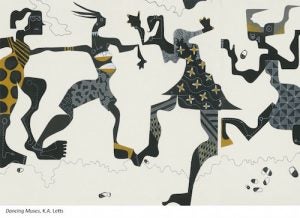Dancing Muses

Dancing Muses by K. A. Letts. Source: a3arts.org.
In this piece, for the Power Art program, K. A. Letts features several black figured dancers who are supposed to be dancing muses. The idea of an inspirational muse is derived from Greek mythology. In mythology muses were figures of inspiration for the science, arts, and literatures. There were nine muses in total that embodied the knowledge in their subjects; Calliope (epic poetry and rhetoric), Cio (history), Erato (singing), Eutere (lyric poetry), Melpomene (tragedy), Polymnia (hymns to the gods and heroes), Terpsichore or Stesichore (dance), Thalia (comedy), and Urania (astronomy) (ancient.eu).
In partnership with the Ann Arbor Downtown Development Authority (AADDA) and the Ann Arbor Public Art Commission (AAPAC), the Arts Alliance manages, selects, and installs artwork by local artists on power boxes throughout downtown Ann Arbor. “Projects like PowerArt! exist across the country, and have led to a decrease in vandalism where installed” (a3arts.org). The vinyl material used to wrap the artwork is resistant to graffiti and can be replaced if damaged. In addition to decreasing vandalism as well being graffiti resistant, these works also serve to beautify the city by transforming industrial looking electrical boxes, which are on many streets corners, into art exhibits for the public to enjoy.
[map id=”43″]












